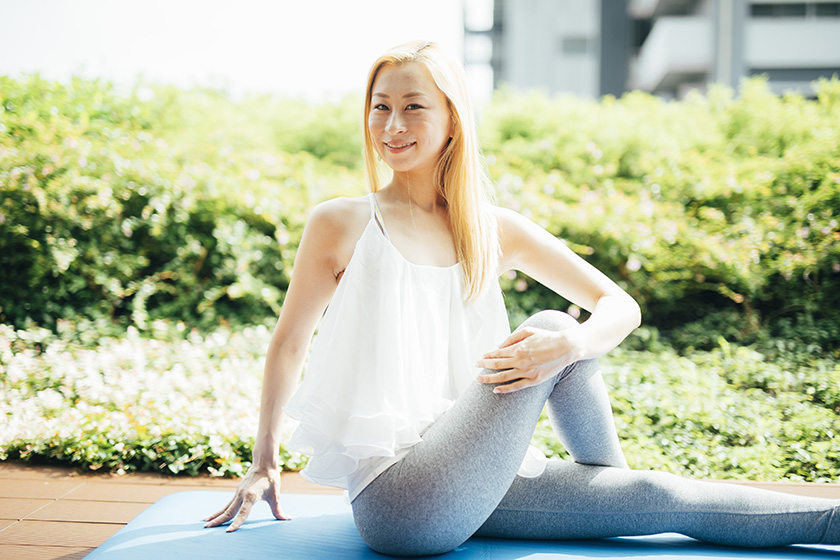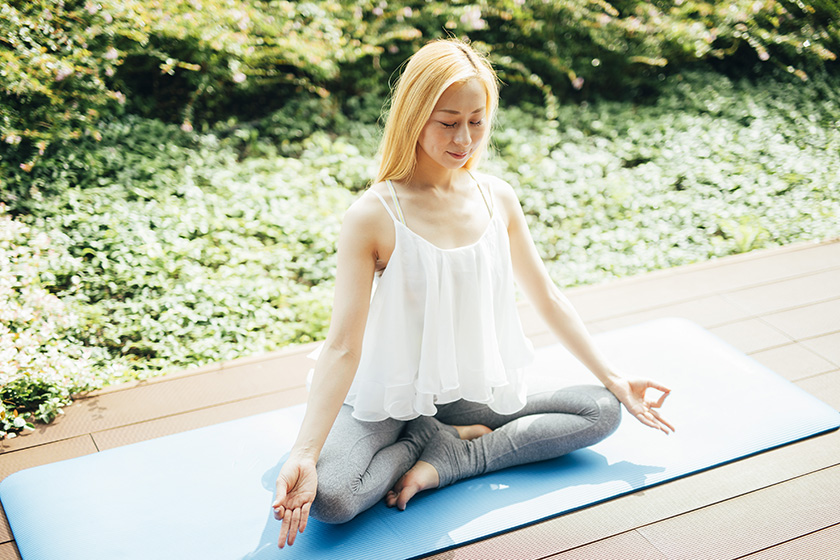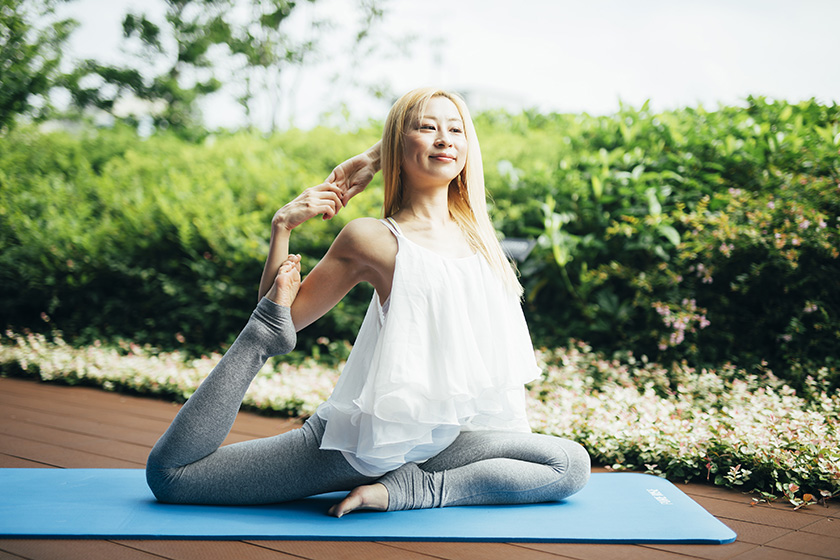As the popularity of yoga continues to soar throughout the world, there is one idea that continues to become more valuable year after year: mindfulness.
The idea of mindfulness has gained the most attention in Europe and North America and while there are any number of different interpretations as to what it signifies exactly, most can agree that it basically has to do with a lifestyle that places great importance on “living in the now.” The idea also includes facets such as practicing yoga and daily meditation, working to improve one’s creativity and ability to concentrate, and keeping track of one’s mental and physical wellbeing. Lauded for its ability to reduce stress and improve concentration, many of the world’s top athletes and celebrities have taken up the mindfulness mindset, and it is now finding its way into corporate employee training and onsite in the fields of medicine and social services.
Wasting no time in recognizing mindfulness and giving it the attention it deserves, Avex brought Wanderlust to Japanese shores for the first time in 2018, hosting a new type of entertainment event combining mindful living with the organic lifestyle. Wanderlust in the U.S. has been able to attract over 50,000 participants, and has spread to 60 cities in 17 different countries including Canada, Australia, and New Zealand. The event combines a five kilometer run, 90 minutes of yoga, and meditation, all held out in the expanse of nature.
For last year’s event, we interviewed members of Avex Entertainment’s production staff who helped put Wanderlust 2018 together: Shigeyoshi Sakamoto, Mikiko Sakuramata, and Naoki Ikushima. For the event’s second year, we would like to focus on one of the event’s major themes of mindfulness. What exactly does the term mean? To get to the bottom of this question, we spoke with Aya, an instructor who boasts teaching 200 classes of her own special brand of yoga per month, a style that focuses on presenting the self elegantly; has operated her own yoga studio for the past year and a half where she teaches Charisma Yoga, a style she herself created; and will be once again taking up the mantle of teaching yoga at this year’s Wanderlust.

Gaining Confidence
through Yoga:
How Aya Puts Mindfulness to
Work in Her Daily Life

“The idea of mindfulness still hasn’t really made its way over to Japan yet, but when I started practicing yoga in the U.S. over ten years ago, it was something that everyone already seemed to be aware of.”
Aya first encountered yoga when she was studying abroad in the United States. She was involved in an accident, and suffering from the pain of whiplash, a teacher at her school recommended that she try yoga.
“At the time I couldn’t really understand English, and ended up taking a class about meditation. Since I was still in my teens at the time, I’m sure you can imagine that I had next to no interest when it came to that kind of thing (laughs).”
Back in Japan, at that time mindfulness was of course still relatively unknown, but even yoga itself was nowhere near as popular as it has become in recent years.
“I put on some weight while I was living in America and thought, ‘I’ve got to do something about this.’ I figured that yoga would be something that I might be able to handle. You know, just give it a shot. I didn’t approach it seriously at all in the beginning (laughs). But, from the very start, something that we would hear over and over again in class was this word ‘mindfulness.’”
While Aya did not think yoga was, in her own words, “very much fun,” she kept with it, and as it gradually turned into something of a hobby with her, she began to realize changes in her body.
“I was always very happy the first time I was able to do a pose. My weight started dropping, which in turn gave me more confidence as a result. My whole lifestyle changed, and more and more I found myself becoming totally absorbed in practicing yoga. I started to really take it seriously.”
For three years in a row, Aya set out to study yoga from as many different perspectives as she could, including making three month sojourns to southern India, renowned for being the promise land among yogis and yoginis. What propelled her to create her own style of yoga was at the behest of a friend who told asked her, “If you’re going to sink so much of your money into yoga, why don’t you try to make some of it back?” Hearing those words proved to be a huge motivator.
Adding stretches, ballet techniques, and deep breathing to traditional yoga, Aya – without a formal yoga instructor of her own – learned, implemented, and practiced her way towards creating her own method of yoga.
“I don’t instruct my students when it comes to what they eat. You know how ladies can be; you try to be strict and tell them, “Don’t eat this,” and they immediately turn around and binge. What’s important is changing on your own. Once your body starts to change, the self will change as well. Mindfulness has a profound effect on diet as well. Have you ever heard about mid-dining meditation?”
So here we ask Aya again: what exactly is mindfulness? How does she perceive it? How does she approach it?
“I’m often asked, ‘I’ve heard the word before, but how do I know what kind of state constitutes mindfulness?’ Well, mindfulness means ‘to live in the now,’ ‘to live in this moment.’ For instance, when I was coming up here for this interview today, I got on an elevator. Being mindful means to remember the number of people on the elevator with me, what kind of people they were, what sort of stuff they were carrying, remembering all those things. If you’re thinking, ‘Oh drat, what time was that meeting I have this afternoon?’ while you’re on the elevator, you won’t notice what’s around you, right? There are lots of people in meetings who spend the whole time staring at the documents sitting in front of them, but being mindful means to look the person you’re engaging with in the eye, listen to what he or she is saying, and ask questions that come to mind, stuff like that. It’s what you could call ‘participating in the meeting.’ It’s the same with dining. If you’re concentrated on the act of eating, even if you’re at a restaurant you go to all the time, even if it’s the same old dish you always get, you’ll notice that it tastes a little richer, the bread seems a little fluffier. If you concentrate, you’ll notice many more things, and you can put that ability to work at your job.”
By focusing on the here-and-now, you can expect to improve your communication, your efficiency at work, and see better results. Aya emphasizes this as the reason that so many companies have been implementing mindfulness into their business operations.
Five Methods to
Be More Mindful
And The Results One
Can Expect to See

According to Aya, there are five methods for drawing out one’s inner mindfulness.
“The first is breathing. Concentrate on inhaling and exhaling. Second is awareness. For example, close your eyes and focus on your body. Feel every bit of your body, from the tips of your fingers down to your toes. By doing that, you’ll become more aware of yourself. It’s important to feel yourself within the scope of your consciousness. Third is walking meditation. Be aware of yourself moving. For instance, think about the manner in which you walk. Feel the way you physically are as you move. Fourth is, like I mentioned before, mid-dining meditation. Develop your sense of taste. Fifth is compassionate meditation. Think about things other than yourself and meditate on your desire for others to be happy.”
Aya says that you should pursue these practices, even just one of them, for eight weeks.
“People say that mindfulness bears fruit after eight weeks. There are plenty of people who say keeping up with it every day is difficult, but really it’s just important to do what you can. We all have different abilities. Just concentrate while you eat, or just try counting the number of people you ride up the elevator with to the office each morning, check to see what shoes your boss is wearing every day — what’s important is to keep conscious of what’s going on around you, to give yourself the kind of stimuli and change to perception that’s outside of your regular routine.”
While it may be hard to concentrate on breathing with that first breath in the beginning, Aya says that keeping with it is the most important aspect. To finally reach a metal state of mindfulness, you need to view yourself objectively and you need to keep your attention focused on things outside of yourself.
“What’s important is to not get swept up in the current of things but to be conscious of the things you yourself are doing. For people who say they’re not limber enough to do yoga, even if you can’t do it, if you stick with it in your own not-being-able-to-do-it way, a change will undoubtedly come about.”
Aya wrote her second book – released this July and titled Ikki ni Kubireru Aya Yoga Senaka Kakumei (published by Shufu no Yusha) – specifically for those kinds of people. The book introduces readers to exercises that anybody can understand, are easy to perform, and show results.
“You’ll really be surprised at how easy they are to do, and I think it’s good that people who add them to their routine will see a change in how they perceive their bodies.”
Experiencing Mindfulness
at Wanderlust:
Experiencing a Brand
New You in a Different Environment

We then asked Aya about how mindfulness is related to Wanderlust as well as the concept behind the event itself.
“We hold Wanderlust outdoors, which I think is perfect since that feeling of openness allows people to really take a better look at themselves in terms of where they are going with their lives. When we start to feel detached from nature, we begin to wonder what it is we are doing in the environment we’re in. Outdoors you can really move around, making it a perfect setting for an event where we’re looking to improve our physical strength. I think it’s an excellent opportunity to reevaluate ourselves and to try to build the foundations for a better way of living.”
She continues:
“But first and foremost when it comes to Wanderlust is for people to enjoy themselves. Yoga has some moves you could compare to dance moves, and people get pumped up like they would on a dance floor. I think it’s a great place for people with no experience to try it out. Last year we had lots of questions from people asking if they had to do the whole shebang: running, yoga, and meditation; I just want to say that those who want to participate in everything are welcome to, but people can also participate in just the things they want to as well. We’ve set plenty of time aside for the running portion, so there are even some people who just walk the course talking with others as they go. How you enjoy it is up to you. We don’t want anyone to keep him or herself from feeling the emotions and sensations they do moment to moment during Wanderlust.”
The running is not timed. Yoga sessions are held both in the outdoors as well as in town with DJs, music, and added dance elements. Meditation allows participants to enter a deeply relaxed state, calming their minds. Through these three programs, participants can expect to refresh their bodies and their souls.
“The point of Wanderlust is to enjoy things that are outside of the ordinary, outside our everyday lives. You can’t experience the kind of atmosphere one gets when doing yoga with 1,000 other people if you’re inside a yoga studio. There are also live music experiences on offer that you can’t find anywhere else. There still aren’t many specialized events here in Japan yet where people can experience mindfulness. It’s a very important event where people come to terms with their own existence and think about the spirit of cooperation with others. There are sessions where we take our neighbors by the shoulders and work to communicate with them, hug them, allowing people to get the kind of experiences you won’t often find here in Japan. Even just witnessing that is invigorating. I think people that come with an open mind will really enjoy the event.”
Listening to Aya speak so lightheartedly and enjoyably brings to mind the idea that perhaps yoga and meditation are not the difficult, imposing kinds of practices one might assume they are. Perhaps making mindfulness part of our day through things that we feel we can stick with, or through Wanderlust, or however, is really only as hard as something like making sure to brush our teeth every day.
Wanderlust 2019 will be held in Fukuoka on Saturday, Sept. 22; Osaka on Saturday, Oct. 5; and Tokyo on Oct. 19 and 20. Avex looks forward to using our knowhow – cultivated over years of experience in the entertainment industry – to the benefit of the kind of one and only event like Wanderlust and help spread the word throughout Japan about mindful living.
Aya (Yoga Creator)
Introduced to yoga while studying abroad in the United States,
Aya was able to lose over 20 kg practicing the ancient Indian discipline.
After studying a variety of different styles of yoga, she become an instructor herself.
Running over 200 classes a month featuring her own unique style of yoga, many of her students include famous actresses and models to the point where spots in her classes have become hard to come by, securing her position as a very popular yoga instructor.









